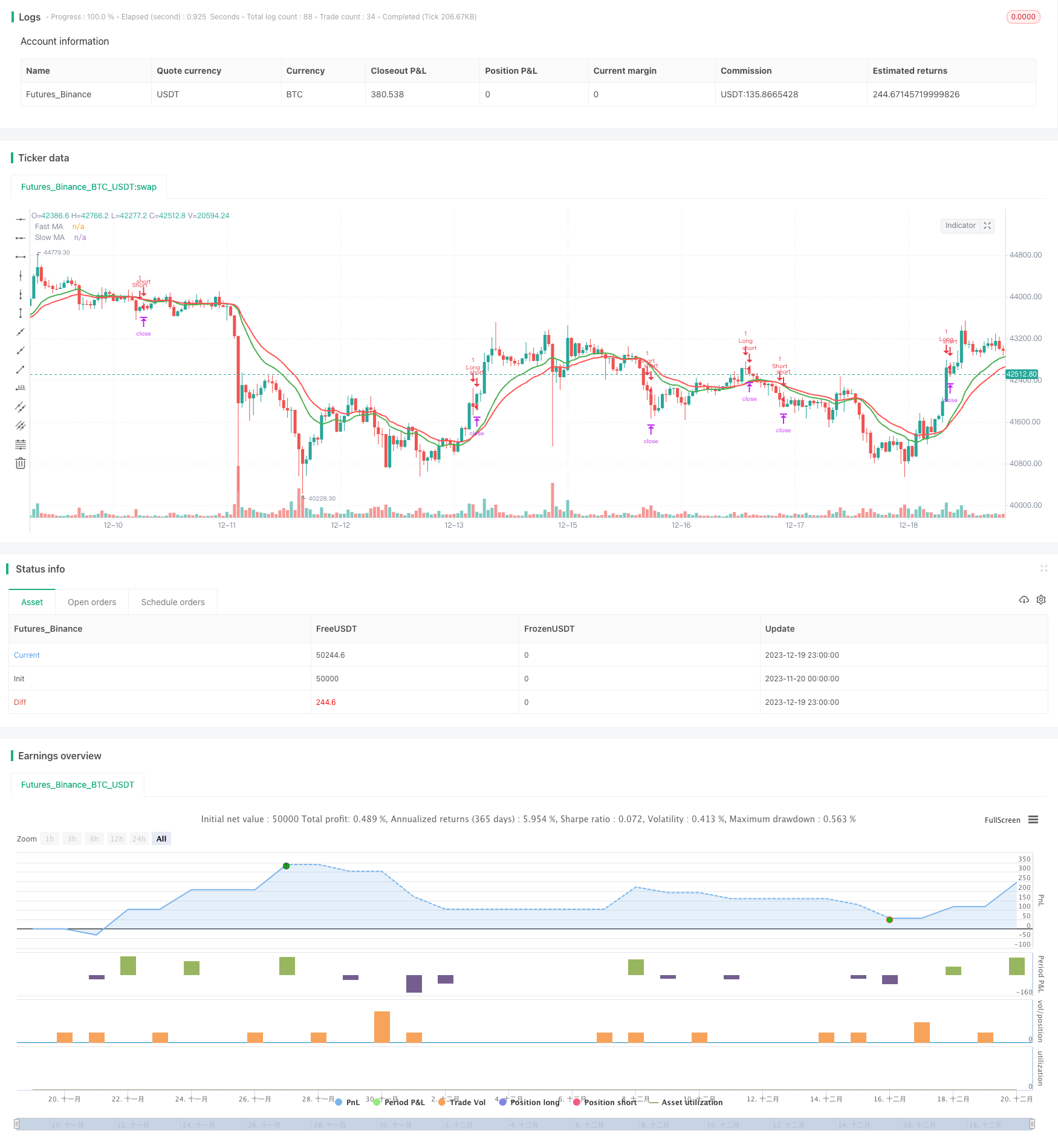Doppelte MA Crossover-Trendfolgestrategie

Überblick
Diese Strategie verwendet die typische Trend-Tracking-Methode der doppelten Gleichgewichtskreuzung und kombiniert Risikomanagementmechanismen wie Stop-Loss, Stop-Stop und Tracking-Stop-Loss mit dem Ziel, die Vorteile von Trendbewegungen zu erfassen.
Strategieprinzip
- Berechnen Sie den mittleren EMA für eine schnelle Periode von n Tagen als kurzfristigen Mittelwert.
- Berechnen Sie den langfristigen Mittelwert der EMA für m Tage im langsamen Tempo.
- Wenn die kurzfristige Durchschnittslinie von unten nach oben durchbricht, machen Sie mehr; wenn sie von oben nach unten durchbricht, machen Sie weniger;
- Gleichlagebedingungen: Rückschlag (wenn mehrere Durchbrüche gemacht werden, ist der Rückschlag gleich).
- Risikomanagement mit Stop Loss, Stop Stop und Tracking Stop Loss
Analyse der Stärken
- Die Verwendung einer doppelten EMA-Grenze ermöglicht eine bessere Beurteilung des Preistrend-Wendepunkts und die Erfassung der Trends.
- In Kombination mit Stop-Loss, Stop-Stops und Tracking-Stops können Sie einzelne Verluste effektiv kontrollieren, Gewinne sperren und Rücknahmen reduzieren.
- Die Parameter sind individuell anpassbar und optimierbar für verschiedene Sorten und Umgebungen.
- Die Strategie ist klar und einfach zu verstehen und zu ändern.
- Es wird unterstützt, mehrere Aktivierungen durchzuführen, die sich an verschiedene Arten von Situationen anpassen können.
Risikoanalyse
- Die Doppel-Einheit-Strategie ist sehr empfindlich gegen falsche Durchbrüche und leicht zu erwischen.
- Unkorrekt eingestellte Parameter können zu häufigen Transaktionen, erhöhten Transaktionskosten und Verlusten von Gleitpunkten führen.
- Die Strategie allein kann keine Trendwendepunkte bestimmen, sondern muss mit anderen Indikatoren kombiniert werden.
- In einem konjunkturellen Umfeld ist es leicht, Handelssignale zu erzeugen, aber die tatsächliche Profitabilität ist schlechter.
- Die Parameter müssen für verschiedene Sorten und Umgebungen optimiert werden.
Das Risiko kann durch folgende Maßnahmen verringert werden:
- In Kombination mit anderen Indikatoren wird die Filterung von False Breaks durchgeführt.
- Optimierung der Parameter-Einstellungen, um die Häufigkeit der Transaktionen zu verringern.
- Es ist wichtig, die Trend-Indikatoren zu erhöhen, um einen wackligen Handel zu vermeiden.
- Umstellung des Positionsmanagements zur Verringerung des Einzelspielrisikos.
Optimierungsrichtung
Diese Strategie kann in folgenden Bereichen optimiert werden:
- Optimierung der Zyklusparameter für schnelle und langsame Durchschnittslinien, um sie an verschiedene Sorten und Umgebungen anzupassen.
- Hinzufügen von anderen Indikatoren, um Trends zu beurteilen und falsche Durchbruchsignale zu filtern. Typisch kann MACD, KDJ usw. hinzugefügt werden.
- Es kann in Erwägung gezogen werden, die EMA in einen SMA oder einen gewichteten Moving Average (WMA) umzuwandeln.
- Stelldistanz basierend auf ATR-Dynamik.
- Aufgrund der Positionsverwaltung können die einzelnen Positionen flexibel angepasst werden.
- Optimierung der Parameter basierend auf einer Kombination aus Relevanz- und Volatilitätsindikatoren.
Zusammenfassen
Diese Strategie ist insgesamt eine typische Trendverfolgung mit zwei EMA-Gleichlinien. Sie hat die Vorteile, Trends zu erfassen und Risikomanagement-Methoden wie Stop Loss, Stop Stop und Stop Loss zu verfolgen. Allerdings gibt es einige typische Probleme, wie eine hohe Sensitivität für Lärm- und Schokehandel, die leicht eingeschlossen werden können. Die Wirksamkeit der Strategie kann durch die Einführung anderer Hilfsindikatoren, Parameteroptimierung, Dynamik-Anpassung und Kombinationsnutzung weiter verbessert werden.
/*backtest
start: 2023-11-20 00:00:00
end: 2023-12-20 00:00:00
period: 1h
basePeriod: 15m
exchanges: [{"eid":"Futures_Binance","currency":"BTC_USDT"}]
*/
//@version=2
strategy(title = "Strategy Code Example", shorttitle = "Strategy Code Example", overlay = true)
// Revision: 1
// Author: @JayRogers
//
// *** THIS IS JUST AN EXAMPLE OF STRATEGY RISK MANAGEMENT CODE IMPLEMENTATION ***
// === GENERAL INPUTS ===
// short ma
maFastSource = input(defval = open, title = "Fast MA Source")
maFastLength = input(defval = 14, title = "Fast MA Period", minval = 1)
// long ma
maSlowSource = input(defval = open, title = "Slow MA Source")
maSlowLength = input(defval = 21, title = "Slow MA Period", minval = 1)
// === STRATEGY RELATED INPUTS ===
tradeInvert = input(defval = false, title = "Invert Trade Direction?")
// the risk management inputs
inpTakeProfit = input(defval = 1000, title = "Take Profit", minval = 0)
inpStopLoss = input(defval = 200, title = "Stop Loss", minval = 0)
inpTrailStop = input(defval = 200, title = "Trailing Stop Loss", minval = 0)
inpTrailOffset = input(defval = 0, title = "Trailing Stop Loss Offset", minval = 0)
// === RISK MANAGEMENT VALUE PREP ===
// if an input is less than 1, assuming not wanted so we assign 'na' value to disable it.
useTakeProfit = inpTakeProfit >= 1 ? inpTakeProfit : na
useStopLoss = inpStopLoss >= 1 ? inpStopLoss : na
useTrailStop = inpTrailStop >= 1 ? inpTrailStop : na
useTrailOffset = inpTrailOffset >= 1 ? inpTrailOffset : na
// === SERIES SETUP ===
/// a couple of ma's..
maFast = ema(maFastSource, maFastLength)
maSlow = ema(maSlowSource, maSlowLength)
// === PLOTTING ===
fast = plot(maFast, title = "Fast MA", color = green, linewidth = 2, style = line, transp = 50)
slow = plot(maSlow, title = "Slow MA", color = red, linewidth = 2, style = line, transp = 50)
// === LOGIC ===
// is fast ma above slow ma?
aboveBelow = maFast >= maSlow ? true : false
// are we inverting our trade direction?
tradeDirection = tradeInvert ? aboveBelow ? false : true : aboveBelow ? true : false
// === STRATEGY - LONG POSITION EXECUTION ===
enterLong() => not tradeDirection[1] and tradeDirection // functions can be used to wrap up and work out complex conditions
exitLong() => tradeDirection[1] and not tradeDirection
strategy.entry(id = "Long", long = true, when = enterLong()) // use function or simple condition to decide when to get in
strategy.close(id = "Long", when = exitLong()) // ...and when to get out
// === STRATEGY - SHORT POSITION EXECUTION ===
enterShort() => tradeDirection[1] and not tradeDirection
exitShort() => not tradeDirection[1] and tradeDirection
strategy.entry(id = "Short", long = false, when = enterShort())
strategy.close(id = "Short", when = exitShort())
// === STRATEGY RISK MANAGEMENT EXECUTION ===
// finally, make use of all the earlier values we got prepped
strategy.exit("Exit Long", from_entry = "Long", profit = useTakeProfit, loss = useStopLoss, trail_points = useTrailStop, trail_offset = useTrailOffset)
strategy.exit("Exit Short", from_entry = "Short", profit = useTakeProfit, loss = useStopLoss, trail_points = useTrailStop, trail_offset = useTrailOffset)